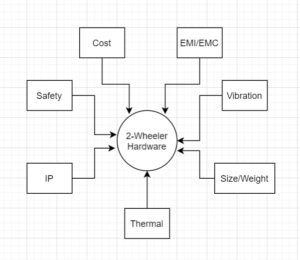HARDWARE IN ELECTRIC 2W
Hardware industry is a very versatile industry with new developments happening continuously in various parts of the globe in various industry sectors. Similarly, automotive industry in an over 100 year old industry. Here we are talking about electric vehicles, majorly 2-wheeler industry. Now electric 2-wheeler is a new industry where hardware is becoming integral part of automotive industry. Hardware on vehicle is a different game. We will be discussing some of the challenges that hardware on a 2-wheeler poses.
Some of the major challenges we will cover are – EMI/EMC, Safety, size and weight, Thermals, Vibration, and Ingress protection. Because of putting it on a 2-wheeler, these 6 become much more connected that in a general hardware design.
EMI/EMC– normally 2-wheelers must pass radiated emissions and immunity. That requires for coming up with great designs, metal enclosures, filtering. Now the counter point is metal enclosure increases weight, is more costly. Common mode chokes will dissipate and will influence thermals. They also reduce power density of designs.
Safety– The moment we go more that 60V dc, safety becomes a concern on EV. We need to maintain isolation and insulation. Isolation and insulation require either dielectric materials at concerned places or maintaining creepage and clearance. Earthing is crucial. All this again makes the system complicated and reduces power density, increase size and cost.
Size and weight – One of the differences between 2-wheeler and 4-wheeler is space and weight constrain. Every cm3 counts and every kg impacts the range and vehicle dynamics. So, hardware design on 2-wheeler demands for high power density designs which are much more compact and light weight. Now this is countering the points we discussed on safety and EMC.
Thermals – Hardware designs will always have some inefficiency. Inefficiency means there will be heat loss from the system, which needs to be taken out. As discussed above the requirement for hardware on 2W is small size, lower weight and sealing. All these are very countering points to thermals. We cannot blow air directly on the devices as that will lead to IP (ingress protection) failure. We put semiconductor devices in contact with enclosure and then try and take-out heat from enclosure. But then this creates challenges like EMC and assembly.

Vibration – Automotive designs are subjected to high amount of vibration and shocks. We might come up with solutions like gluing/ encapsulation or using special parts. Now this impacts weight, assembly and eventually cost.
Ingress protection – Hardware being on vehicle requires sealing. IP numbers and ratings are open for discussion. Now solving for IP creates thermal and weight challenges. Also cost increases
Cost – Eventually everything come to cost. As discussed, there is always a requirement for Robust and Compact Solutions. These require out of the box solutions. There is a requirement for customized components. Example being getting a customized Electrolytic capacitor for taking care of vibration or making PCB in a non-standard shape. All this eventually cost more.
Hardware on a 2-wheeler needs much more holistic approach in design and analysis. The Engineers are required to understand much more than just Mechanical or Electrical or standards. This makes these hardware designs very challenging and interesting. There are multiple battles happening together and a designer needs to understand which battle to fight and which is not worth fighting.

